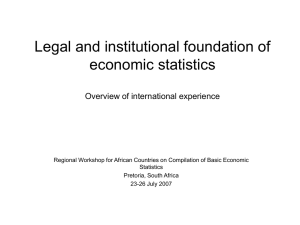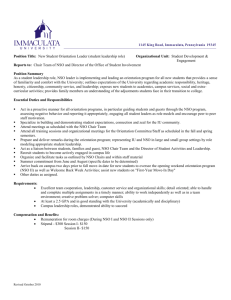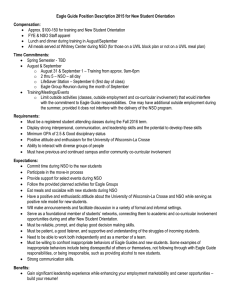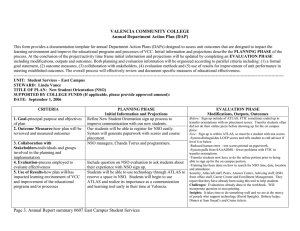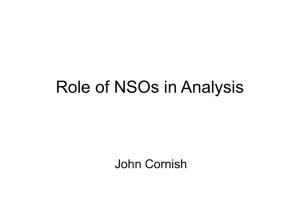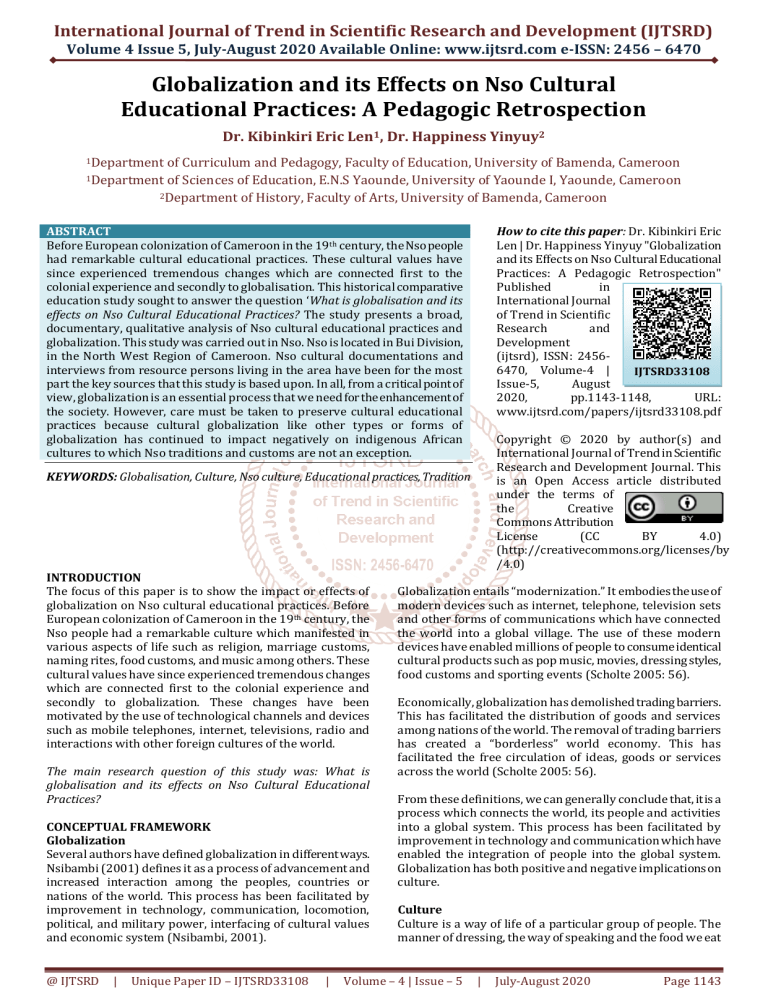
International Journal of Trend in Scientific Research and Development (IJTSRD)
Volume 4 Issue 5, July-August 2020 Available Online: www.ijtsrd.com e-ISSN: 2456 – 6470
Globalization and its Effects on Nso Cultural
Educational Practices: A Pedagogic Retrospection
Dr. Kibinkiri Eric Len1, Dr. Happiness Yinyuy2
1Department
of Curriculum and Pedagogy, Faculty of Education, University of Bamenda, Cameroon
of Sciences of Education, E.N.S Yaounde, University of Yaounde I, Yaounde, Cameroon
2Department of History, Faculty of Arts, University of Bamenda, Cameroon
1Department
ABSTRACT
Before European colonization of Cameroon in the 19th century, the Nso people
had remarkable cultural educational practices. These cultural values have
since experienced tremendous changes which are connected first to the
colonial experience and secondly to globalisation. This historical comparative
education study sought to answer the question ‘What is globalisation and its
effects on Nso Cultural Educational Practices? The study presents a broad,
documentary, qualitative analysis of Nso cultural educational practices and
globalization. This study was carried out in Nso. Nso is located in Bui Division,
in the North West Region of Cameroon. Nso cultural documentations and
interviews from resource persons living in the area have been for the most
part the key sources that this study is based upon. In all, from a critical point of
view, globalization is an essential process that we need for the enhancement of
the society. However, care must be taken to preserve cultural educational
practices because cultural globalization like other types or forms of
globalization has continued to impact negatively on indigenous African
cultures to which Nso traditions and customs are not an exception.
How to cite this paper: Dr. Kibinkiri Eric
Len | Dr. Happiness Yinyuy "Globalization
and its Effects on Nso Cultural Educational
Practices: A Pedagogic Retrospection"
Published
in
International Journal
of Trend in Scientific
Research
and
Development
(ijtsrd), ISSN: 24566470, Volume-4 |
IJTSRD33108
Issue-5,
August
2020,
pp.1143-1148,
URL:
www.ijtsrd.com/papers/ijtsrd33108.pdf
Copyright © 2020 by author(s) and
International Journal of Trend in Scientific
Research and Development Journal. This
is an Open Access article distributed
under the terms of
the
Creative
Commons Attribution
License
(CC
BY
4.0)
(http://creativecommons.org/licenses/by
/4.0)
KEYWORDS: Globalisation, Culture, Nso culture, Educational practices, Tradition
INTRODUCTION
The focus of this paper is to show the impact or effects of
globalization on Nso cultural educational practices. Before
European colonization of Cameroon in the 19th century, the
Nso people had a remarkable culture which manifested in
various aspects of life such as religion, marriage customs,
naming rites, food customs, and music among others. These
cultural values have since experienced tremendous changes
which are connected first to the colonial experience and
secondly to globalization. These changes have been
motivated by the use of technological channels and devices
such as mobile telephones, internet, televisions, radio and
interactions with other foreign cultures of the world.
The main research question of this study was: What is
globalisation and its effects on Nso Cultural Educational
Practices?
CONCEPTUAL FRAMEWORK
Globalization
Several authors have defined globalization in different ways.
Nsibambi (2001) defines it as a process of advancement and
increased interaction among the peoples, countries or
nations of the world. This process has been facilitated by
improvement in technology, communication, locomotion,
political, and military power, interfacing of cultural values
and economic system (Nsibambi, 2001).
@ IJTSRD
|
Unique Paper ID – IJTSRD33108
|
Globalization entails “modernization.” It embodies the use of
modern devices such as internet, telephone, television sets
and other forms of communications which have connected
the world into a global village. The use of these modern
devices have enabled millions of people to consume identical
cultural products such as pop music, movies, dressing styles,
food customs and sporting events (Scholte 2005: 56).
Economically, globalization has demolished trading barriers.
This has facilitated the distribution of goods and services
among nations of the world. The removal of trading barriers
has created a “borderless” world economy. This has
facilitated the free circulation of ideas, goods or services
across the world (Scholte 2005: 56).
From these definitions, we can generally conclude that, it is a
process which connects the world, its people and activities
into a global system. This process has been facilitated by
improvement in technology and communication which have
enabled the integration of people into the global system.
Globalization has both positive and negative implications on
culture.
Culture
Culture is a way of life of a particular group of people. The
manner of dressing, the way of speaking and the food we eat
Volume – 4 | Issue – 5
|
July-August 2020
Page 1143
International Journal of Trend in Scientific Research and Development (IJTSRD) @ www.ijtsrd.com eISSN: 2456-6470
defines culture (Krober, 1963: 10). He further explains that
culture is not static but it is dynamic. As people evolve,
culture also changes. It embodies all capabilities and habits
learned as members of a society. Culture involves the
patterns of the society such as arts, beliefs and behavioral
norms amongst others. It is therefore the totality of ideas,
concepts and values that characterize and identify a
particular group of people (Kassam, 2000: 197).In order to
better address the issue we will first examine some aspects
of Nso culture. These include religion, marriage custom, child
birth, traditional baptism, traditional communication tools,
dressing and food customs.
RESEARCH METHODOLOGY
This study was carried out in Nso. Nso is located in Bui
Division, in the North West Region of Cameroon. The area is
divided into four administrative sub divisions: Kumbo
(630km2), Jakiri or Dzekwa (675km2), Nkum (375.3km2)
and Mbiame or Mbvem (575km2) (Njilla, 2009: 9). Nso is
one of the Tikar fondoms of the Western grass fields of
Cameroon. The Tikar fondoms in the Bamenda grass fields
include Nso, Kom, Warr, Bafut, Wiya, Fongom, Tang, Bum,
Mbem, Bambili, Mfumte, Oku, Bamunka, Bambalang,
Babungo, Bamali, Bafanji and Bamessi. Their dynastic clan
forefathers originated from places such as Tibati, Banyo,
Ndobo, Kimi, Bankim and Rifum. These peoples recognize
relations with one another mainly on grounds of dynastic
origin and the general linguistic similarities shared by many
of the cis Mbam peoples. The Nso described their place of
origin as Rifum which is present day Bankim (Chilver and
Kaberry, 1967:11).
The vernacular or mother tongue used by Nso people is
called ‘Lamnso’. Currently English and French are widely
spoken in the area. English and French are the official
languages of the country that came as a result of the dual
colonial heritage. Cameroon was colonized by the British and
the French. This is a historical comparative education study
that analyses globalization and its effects on cultural
educational practices. The purpose of the study is to carry
out a broad, documentary, qualitative analysis of Nso
cultural educational practices and globalization.
The choice of Nso was because the researchers come from
this area and are deeply concerned with the significant
changes in cultural educational practices which are
connected first to the colonial experience and secondly to
globalization. These changes have been motivated by the use
of technological channels and devices such as mobile
telephones, internet, televisions, radio and interactions with
other foreign cultures of the world.
Nso cultural documentations and interviews from resource
persons living in the area have been for the most part the
key sources that this study is based upon. Oral interview and
historical documentations about the Nso culture were used
to collect data. Interview permitted the participants to
express themselves freely to provide sufficient information
for the study. Eight resource persons who originate from Nso
were interviewed. Each interview took about one hour. The
interviews were carried out in 2015 and 2016 at the
residence of each participant. The data collection process
began with a presentation of the objective of the study to the
participants. Information provided was recorded using a
digital recorde. Each interview was transcribed. The data
@ IJTSRD
|
Unique Paper ID – IJTSRD33108
|
collected was categorized, presented and analysed according
to themes. Data collected from historical documentation was
used to corroborate data from interview.
FINDINGS: Nso Cultural Educational Practices and
Globalisation
Religion
Religion is an important aspect of Nso culture. Religion is a
term that denotes the notion of divine retribution. It is act of
belief and the worship of God or gods. It shows those beliefs
and practices relative to sacred things. (Yinyuy, 2005: 20).
The indigenous Nso people like their counterparts elsewhere
in Africa, believed in the existence of many gods, Anyuy and
ancestor spirits. The people believe in life after death.
Ancestors were spirits of deceased persons. They believed
that their ancestors were closer both to them and to god and
thus qualified to act as intermediaries between the people
and God. Also, the Nso people still believed in the existence
of the Supreme God who was the creator of the universe,
Nyuymbom. Nevertheless, Nso traditional religion
distinguished between God (Nyuy) and gods (Anyuy – plural
of God). This distinction did not suggest any contradiction
between the two terms. The name God was more of a
universal concept, denoting God as the creator of the world
(universe) while anyuy was used in reference to divine
representations; be it a compound, river site, escarpment or
cave. It was common to hear the lineage head or priest made
incantations “to the gods of the land” .The power or
puissance of the supreme God was made visible in natural
creations like wind, rivers, trees, caves, the sky and stones.
Some of these objects were associated with myth of creation.
It was assumed that some of the gods were living in some of
these objects like stones, caves and rivers (Yinyuy, 2005: 20).
The sites of some of these objects were used as shrines
where various religious rites or rituals were performed.
Shrines were also created on the graves of the fons, family or
quarter heads such as afaay. Traditional religious rites were
presided over by the Fon, afaay(lineage heads), tawong
(father of the land), yewong, the queen mother and the chief
priest, Tanyuy (Lamla, 1995: 14)among others. The Fon was
the Chief priest of the land. Quarter and family heads also
performed similar ritual sacrifices like the fon in their
spheres of influence. They offered prayers and sacrifices to
the gods pleading for good health, peace and prosperity on
the land. The use of objects like stones, calabashes, baskets,
trees and shrines enabled European missionaries to rate the
Nso people as idol worshippers. Besides, the significance of
ancestors in their religious practices led the missionaries to
erroneously insinuate that these spirits were worshipped.
Pejorative words were used to describe non-Christians and
traditional practitioners such as idol worshippers or
“pagans.” (Saker, 1968:67).
The Nso people equally believed in the existence of
witchcraft which they regarded as a force responsible for
evil happenings. Hence, when a woman died in pregnancy for
instance, she was accused of witchcraft and her corpse was
thrown in the bush without proper burial. Also, when a
youth or someone died in his prime, it was attributed to
witchcraft. The Nso people held that God made people to die
only in their old ages. Natural calamities such as famine, or
the outbreak of diseases and drought were also attributed to
witchcraft. For instance, when locusts or some insects
attacked and destroyed crops and animals, it was seen as a
Volume – 4 | Issue – 5
|
July-August 2020
Page 1144
International Journal of Trend in Scientific Research and Development (IJTSRD) @ www.ijtsrd.com eISSN: 2456-6470
curse on the land. Although the Nso people believed in the
existence of witchcraft, they had no scientific knowledge to
prove it. Investigations on witchcraft were further carried
out `by consulting a sorcerer, nga ngam. Any suspector the
accused was severely beaten and forced to bring his or her
god of witchcraft (nyuyarim) to be burnt, with the
assumption that burning would helped to destroy it (Yinyuy,
2011: 37).
Protection against witchcraft was provided through a
common rite called nguv, which is a liquid concocted from
leaves, backs and roots of trees believed to have
supernatural forces. After an invocation and sanctification,
the officiating priest gave each participant a share of the
concoction to drink. The solemnity with which the act of
drinking the concoction took place led Mbuy, (1992: 26) to
describe this ceremony as the “most solemn ritual in Nso
religion. It had disastrous effect on wizards and witches who
drank of the sacred concoction. Any wizard or witch who
drank fell dead. The missionaries condemned this act and
instructed believers to use persistent prayers to defeat
witches and wizards. Moreover, those who confessed their
sins in the Christian faith were saved from condemnation.
However, some Christians in Nsoland still prefer to undergo
this ritual than to confess and renounce witchcraft.
With the advent of Christianity in Nso Fondom modern
hospitals were constructed. Some of the major hospitals
include the Banso Baptist Hospital and the Saint Elizabeth
Catholic Hospital, Shisong. These hospitals have wellconstructed buildings, good medical equipment, drugs and
well trained staff including European medical doctors and
specialists. The health services offered by these hospitals
have greatly improved on the health of Nso indigenes as
most of the drugs are given at subsidized rates. The uses of
modern X-ray systems to examine patients and pregnant
women have helped to dissipate the idea that some diseases
are caused by evil forces (Yinyuy, 2011: 44).
Other sacrifices carried out included Menkan, Ntanri and
Kidiif. (Verye, 2007: 96).Menkan, was an act of benediction
destined to invoke blessings and also to prevent evil spirits
from attacking the people. Ntanri was the sacrifice of
expiation in which people accepted their wrong doings or
fault on others and seek for reconciliation. This was
performed when somebody was critically sick. The patient
offered a goat or fowl, palm wine, kolanut, cornfufu and
egusi as a ransom to the ancestors for the atonement of sin.
Kidiif was a sacrifice of reconciliation which was usually
performed to settle a serious disagreement that caused the
separation of family members, families or fondoms.
Generally, the Nso believe that only palm wine could be used
to carry out a sacrifice. Palm wine was used especially when
carrying a traditional rite where homage was being paid to
the ancestor and/ or divinities when pouring a libation. Palm
wine like kolanut was commonly shared by people who were
in agreement. The use of palm wine symbolizes fellowship,
togetherness, harmony and peace. It plays a central role
during the sacrifice because part of it was poured out for
cleansing and for reconciliation. It was assumed that a cup of
good palm wine would make the diviner to see beyond the
physical world and clarify issues correctly. Palm wine
crowns the occasion especially when there was successful
reconciliation, it enlivens the people to sit down and discuss
other important issues. All these sacrifices were performed
@ IJTSRD
|
Unique Paper ID – IJTSRD33108
|
to restore peace, invoke blessings on the people and ensure
harmony with God and the ancestors.
Assessing activities in the pre-colonial Nso community, one
is bound to criticize the colonial and missionary enterprise
in Africa. It is necessary to note that most missionaries like
their colonial masters from the onset undermined African
culture. No doubt, some African scholars like Coleman (1958:
97) have criticized the missionary’s enterprise in Africa in
the following words:
The early missionaries were inclined to feel that the African
was in the grip of a cruel and irrational system from which
she ought to be liberated …. In their eyes ritual murder,
human sacrifice, and cannibalism were sufficient to
condemn the whole system …. Hence they included among
the preconditions for entry into the Christian fold the
abandonment of such customs as initiation ceremonie s…,
dancing …, marriage payment …, polygyny …, secret
societies not to mention…African names, and traditional
funeral ceremonies. Renunciation of the old order was a
prerequisite to acceptance of the new.(p97)
Furthermore, Falola (2000: 144-145) argues that there was
no doubt that missionaries deliberately propagated an ugly
image of Africa, to serve their own specific needs. To be sure,
they had to justify their presence in Africa, “The darker the
picture of the African barbarism, the more necessary the
work of the missionaries.” Indeed, by showing the deplorable
conditions of things in Africa, the missionaries obviously
sought to arouse not only sympathy, but also increased
support for their missions. It is regrettable that missionary
descriptions of African society as depraved, barbarous, and
uncivilized, shaped and influenced European thoughts and
action in Africa. Thus, in the eyes of early missionaries,
Christianity served as “an efficient instrument to uplift the
African from their barbaric nature.” For this reason,
missionaries perceived themselves as “messengers of
liberation and civilization.”
Traditional Baptism
Furthermore, another important aspect of Nso culture was
traditional baptism or naming rites. Before the advent of
Christianity, the Nso had their traditional religious naming
rite which was carried out on traditional public holidays or
“country Sunday.” TwodaysKiloveey and Ngoiylumwere kept
out of an eight-day week as country Sundays according to
Nso calendar. Country Sundays or vishiyvebam were nonworking days as farm work in particular, was prohibited.
These days were dedicated to perform traditional rites and
sacrifices. (Lamla, 1995). It was assumed that the “gods of
the land” were fully at work to cleanse and bless the land on
such days and therefore people were not allowed to work on
their farms on these days.
The “vishiyvebam” were also days set aside for traditional
baptism. This occasion was surpervised by a high priest,
Tanyuy and/or priestess, Yenyuy. During the traditional
baptism, a child was given an appropriate name according to
Nso naming rites. During this special naming rite, ceremony
blessings of good health and prosperity were pronounced on
the child. He or she was provided a traditional woven raffia
bag which contained a leaf of the peace plant (kikeng),
calabash and cowries (money). It was sealed with the kikeng
plant and incantation of progress declared on him or her as
Volume – 4 | Issue – 5
|
July-August 2020
Page 1145
International Journal of Trend in Scientific Research and Development (IJTSRD) @ www.ijtsrd.com eISSN: 2456-6470
the priest called on God to guide and protect the child.
During this rite, a mixture of salt and red oil was applied on
the child’s body. It was believed that salt would purify or
cleanse the child and protect him or her from evil spirits
while red oil signifies royalty. Generally, children were given
names such as Lukong, Tumi,Shei, Wirba, Wirsungnin,
Wirngoran, Ngoran, Tatah, Ntang and Biy among others.
(Yinyuy, 2005:25).
They wereinstructed to be loyal to their parents and to
respect their elders. The fear of God helped to mould the
character of the people. The naming ceremony took place
mostly during the dry season because of its favorable
weather (Bongasov, 2016). The ceremony ended with merry
making and feasting. In carrying out this rite, the Nso
believed in the supremacy of God as the Great provider of
children and life.
Gradually, Nso traditional baptism is dying out as a
consequence of cultural globalization. Most of the Nso men
and women who have embraced Christianity now baptize
their children in church with Christian names or names
which glorify God. Examples of these names include
Fonyuy(God gives) ,Yinyuy (God’s doing), Berinyuy(Thanks
be to God), Burinyuy(Praise God)….Fanyuy(Fear God). These
names expressed the Nso acknowledgement of God grace in
their lives.
Furthermore, it is vital to note that the advent of new
generation churches, that is Pentecostalism or “born again”
churches (Jehovah Witnesses, Apostolic and Full Gospel
Mission) in Nso, has affected Nso traditional practices. These
new churches generally condemned traditional practices as
evil on the land. Hence, their spiritual leaders and converts
organized deliverance and breakthrough services in which
traditional baptismal bags and local shrines belonging to
their faithfuls are destroyed with fire (Bongasov, 2016). It is
commonly observed that members of these churches in Nso
have a network of chained prayers with other “Men of God”
or prayer warriors across the globe. This network prayers
and spiritual retreats among its members have been
facilitated through the use of the internet, telephone and
Television sets.
Marriage Custom
Marriage was another traditional institution where Nso
culture was expressed. The society was predominantly
polygamous because the number of wives a man had
determined his position in the society. This explains why the
Fon kept as many wives as he could. The vibais (traditional
Lords) and afaay (Lineage heads) equally had more than one
wife while a common man with no title could get married to
one wife if he wanted. The collection of bride wealth
comprised red oil, palm wine, a bag of salt, kolanuts, fried
groundnuts, “bush meat” and other materials like blanket or
the roofing of the bride’s family house. With the complete
payment of the bride wealth, the woman becomes a member
of the husband’s family and took up the name of herhusband.
She only visited her family when necessary. Each lineage
head, received the bride price of his female dependents.
(Banbooye, 2003: 2).
It is important to note that before the bride price was finally
collected, the would–be- husband, friends and family
members frequently visited the girl’s family, with gifts.
@ IJTSRD
|
Unique Paper ID – IJTSRD33108
|
During such interactions, the two families learned much
about each other as they carried out investigations to inquire
if their daughter or son was to be in good hands. The
character of the husband or wife was equally examined by
both family members. (Wiysahnyuy, 2016).
Although, Christian teachings denounced polygamous
marriages, the Fon and some traditional rulers who were
Christians still adhere to polygamy. The implication has been
that, some traditional rulers and men practiced religious
syncretism wherein they participate in traditional and
Christian activities. (Tavmfu Kiyan, 2016). However, despite
the efforts of traditional rulers to maintain polygamous
marriages, many young men in Nso prefer monogamy while
polygamy is declining.
On a positive note, the social media (internet, television and
radio) have played a crucial role to sensitize the world on
health issues, Nso inclusive. Information published on the
internet on health issues has enlightened many people
across the world on bad cultural practices and contraction of
sexually transmitted diseases such as Human Immune
Deficiency Virus/ Acquired Immune Deficiency Syndrome
(HIV/AIDS), syphilis, among others. Information obtained
from these channels has led to the cultural emancipation of
Nso men and women from some poorly conceived cultural
practices such as inherited wives (widow or levirate
marriages), (Mbom, 2016). The information obtained from
the Christian teachings and social media have helped some
widows in Nso to denounce getting married to family
members after the death of their husbands.
Regrettably, the abuse of the media through internet
browsing, dating and unnecessary texting by youths is
lamentable. Generally, in pre-colonial Nso community,
evening hours were meant for storytelling. During this time,
the youths would gather in a hearth and have riddles and
storytelling with the elders. This act enabled them to know
more about their culture as well as history. It is lamenting
that precious time formerly spent by the youths with the
elders to learn more about their culture and history has been
reserved for telephone manipulation. The wrong use of
telephones or internets by the youths to date and even make
marriage arrangements has drastically reduced the
fellowship spirit which formerly existed in Nso between
family members. (Mbom, 2016). This signifies that Nso
marriage custom is gradually losing its identity as some
husbands while abroad call on friends, brothers or fathers to
represent them and marry the wife.
Besides, cultural issues formerly held in secrecy have been
displayed in the internet or announced over the radio and
telephone to the public. A glaring example was seen in the
death announcement of ShufaiSop published on internet on 4
May, 2016 by a non-family member. This information was
published in the internet by a non-family member. This
information was meted out without the intention of the
traditional rulers and the great lords. (Shundzev, 2016).
Considering the fact that in Nso tradition, the death of the
Fon and great traditional lords is followed by certain
procedures before announcements are made by those in
charged, people and more especially the youths who have
grown in this era of globalization should be careful with the
kind of information which is published on the internet.
Volume – 4 | Issue – 5
|
July-August 2020
Page 1146
International Journal of Trend in Scientific Research and Development (IJTSRD) @ www.ijtsrd.com eISSN: 2456-6470
Nso Traditional Dress
The original Nso traditional dress is the Ndzynyav. The Fon,
people from the royal lineage and traditional rulers usually
wore this attire. It was worn with a traditional cap and
decorated traditional bags, made out of raffia. This outfit was
mostly used by the Nso people during cultural ceremonies
(Kumbo Urban Council, 2005). The use of traditional dress,
bags and umbrella is fast disappearing in favor of western
attires. Majority of the Nso men and women now dressed but
in suits, skirts, jeans, trousers and shirts. Moreover most
girls and women in the name of fashion now dress exposing
private parts of their bodies coupled with variegated hair
styles and eye lashes. This “new fashion” spirit has led to an
increase in juvenile delinquency and infidelity in the
community.
Traditional communication
Pre-colonial Nso people had a special way of delivering
information or announcements to the community. They used
a “talking or sounding drum,” calledNgu,. In most cases, the
drum was played to summon elders and warriors, members
of Manjong, the military club so as to inform them on any
important issue that warranted the immediate assembly of
the people. The sound of this drum created a haunting
melody and tune which signified the death of someone or
danger on the land. Whenever it was sounded, people rushed
immediately to the place where it was lodged, to know what
has happened. In this light, the ngu, had the ability to connect
information and equally summon people together. (Yeika,
2016). With the advent of Christianity in Nso Fondom in the
19th century, missionaries adopted the use of ngu,to summon
Christians in the various mission stations especially for
Sunday Service or Christian meeting.
In addition, the Nso people were also summoned in the precolonial time with the use of an elephant tusk. The elephant
tusk was played by the Gweys (war spies). Most of them were
stationed at hill tops to spy foreigners or suspects entering
the territory. When any suspect was seen approaching the
Nsoland, the elephant tusk was played to alert the people. It
produced a sound at a high frequency that extended over a
large area. The Gwey displayed war tactics with spears,
cutlasses, firing of dane guns in a local manner. No adult
male was allowed in the field without a weapon especially, a
machete and scabbard. Also, there was the use of kikengplant
to deliver information from the Fon to the people. (Lukong,
2015). Once, the messenger took the kikeng plant around the
market or village square, people rushed to getthe
information. The uses of these tools were effective and no
false information was delivered.
Food customs
Subsistence agriculture was one of the major economic
activity carried out in Nso. Crops cultivated were millet,
maize, beans, potatoes, yams and vegetables. Men, women
and children were involved in agriculture because it was a
means of survival in the community. It provided food and
equally served as a source of employment to the people.
Besides, the surplus items were used in local trade. The main
traditional meal was corn fufu and vegetables. The people
also hunted animals and gathered food such as mushroom,
vegetables, termites and crickets (Lukong, 2015). These
varieties of foodstuffs were highly nutritional and good for
the health of the people.
@ IJTSRD
|
Unique Paper ID – IJTSRD33108
|
In addressing the issue of food custom in Nso community,
Sa,ber and Tatah, (2016) believe that, the constant
application of fertilizers and pesticides on crops and
vegetables have generated several health problems unlike in
the past where crops were cultivated or preserved naturally.
They go further to admit that the constant use of fertilizers
and chemicals on crops coupled with the consumption of
can- food and drinks from the western world, has been one
of the causes of several diseases affecting people’s health
today. Some of the diseases include diabetes and
hypertension which were not common before.
In a nutshell, the issues discussed above greatly enriched
Nso culture in the pre- colonial era. Even though few of these
practices have survived, their influence is no longer powerful
as it was in the pre-colonial era. The weakening of the Nso
cultural practices is as a result of the impact of colonization
and especially, globalization on the community.
CONCLUSION
In all, from a critical point of view, globalization is an
essential process that we need for the enhancement of the
society. However, care must be taken to preserve cultural
educational practices because cultural globalization like
other types or forms of globalization has continued to impact
negatively on indigenous African cultures to which Nso
traditions and customs are not an exception. Thus, if this
trend continues, some aspects of Nso culture might likely
disappear and posterity will hold us responsible. Even
though Nso traditional religion, food customs, performing of
annual sacrifice and traditional marriage ceremonies still
survive, their influence is no longer greatly felt by the young
ones. The old ones who possess the talent and knowledge
are fast passing away with nobody prepared to learn the
trait from them. We wish to note that it is not everything
about globalization that is bad. It is thanks to the Baptist and
Catholic missionary bodies that the Nso community is
endowed with modern hospitals. These hospitals have wellconstructed buildings which boost the economy of the area.
We should in all honesty copy what is good from the alien
cultures we come in contact with and let go some aspects of
our culture which are not progressive. In doing so, we should
make sure that what we borrow and what we maintain in
our culture will still sustain the solidarity upon which our
indigenous societies existed.
SELECTEDBIBLIOGRAPHY
Primary Source
A. Oral Interviews
[1] Bongasov, Shey Fabian. Kumbo, 04/03/2016.
[2] Lukong, Benedict. Kikaikom, 27/12/2015.
[3] Mbom, Josipher. Bambui-Kiyan, 08/03/2016.
[4] Sa,ber, Henry. To-oy, 08/03/2016.
[5] Tatah, Denis. To-oy, 08/03/2016.
[6] Tavnfu-Kiyan, Kiyan, 05/03/2016.
[7] Wiysahnyuy Angelica. To-oy Kumbo, 04/03/2016.
Published works
[1] Banbooyee, W. (2001)An Introduction to Nso History.
Kumbo: Nso History Society Publication.
[2] Banbooyee, W. (2003)Nso Marriage customs. Kumbo:
Nso History Society publication.
Volume – 4 | Issue – 5
|
July-August 2020
Page 1147
International Journal of Trend in Scientific Research and Development (IJTSRD) @ www.ijtsrd.com eISSN: 2456-6470
[3] Chilver E. M. and Kaberry, P. M. (1967) Traditional
Bamenda: The Pre- Colonial History and Ethnography of
Bamenda Grassfields Vol.I. Buea: Government Printer.
Minimizing the Costs," United Nations General
Assembly, Second Committee Panel Discussion on
Globalisation and the State. P5
[4] Coleman, J. S. (1958) Nigeria: Background to
Nationalism. Berkeley: University of California Press.
[14] Sakah, B. T. (1969) “Nso Magico-Religious Practices”.
Cameroon’s Cultural Review: ABBIA No. 2. Yaounde:
Cameroon.
[5] Falola, T. (2000) African Cultures and Societies before
1885 Vol.2. United States of America: Carolina
Academic Press.
[6] Hastings, A. (1967) The Church and Mission in Modern
Africa. London: Burns and Oates.
[7] Kassam, A. (2000) ”Social Identity and the politics of
Cultural Performance”. Journal of Social Identities vol.6,
[8] Krober, A. L. (1963) An Anthropologist looks at History.
London: University of California Press.
[9] Lamla, G. B. (1995) “The Catholic Church in Nso since
1912: Perpective from Shisong Parish” University of
Yaounde: maitrise diploma. (Unpublished)
[10] Matsumoto, D. (2000) Culture and Psychology: people
Around the World, Second edition, United States of
America: Thomson Learning inc.
[11] Mbuy, T. H. (1992) Understanding Witchcraft Problem
in the Life of an African: Case Study of Cameroon. Oweri
Highspeed Printing.
[12] Njilla, R. M. (2009) “Management of Cameroon Property
Resources for Sustainable Rural Livelihoods in Bui
Division, North West Region of Cameroon”
(Unpublished)
[15] Scholte, J. A. (2005) Globalisation: A critical
Introduction, second Edition. China: Palgrave Macmillan
Publisher.
[16] Verye, F. M. (2007) “The truth and Reconciliation
Commission (TRC) and Nso Kidiif Ritual as Model of
Genuine Reconciliation.” Protestant University of
Central Africa, Yaounde: PhD Thesis. (Unpublished)
[17] Yeika, E. (2016) The Manjong Warrior Society.
Bamenda: Baron Printing House, Cow Street.
[18] Yinyuy, H. (2005) “Nso Response to Colonial
Administration and Christianity 1902-1961.” University
of Buea: Long Essay. (Unpublished)
[19] Yinyuy, H. (2011) “The role and Impact of Christian
Women Fellowship in
Evangelisation in the
Kumbo Zone, Cameroon 1961-2
Internet source
[1] http://www.wikipedia of culture, information accessed
on the 12/02/2011.
[2] Globalnet. http://www.global knowledge, information
assessed on the 19/05/16.
[3] Shundzev website, information accessed on 19/05/16.
[13] Nsibambi. A. (2001) "The Effects of Globalization on
the State in Africa: Harnessing the Benefits and
@ IJTSRD
|
Unique Paper ID – IJTSRD33108
|
Volume – 4 | Issue – 5
|
July-August 2020
Page 1148


